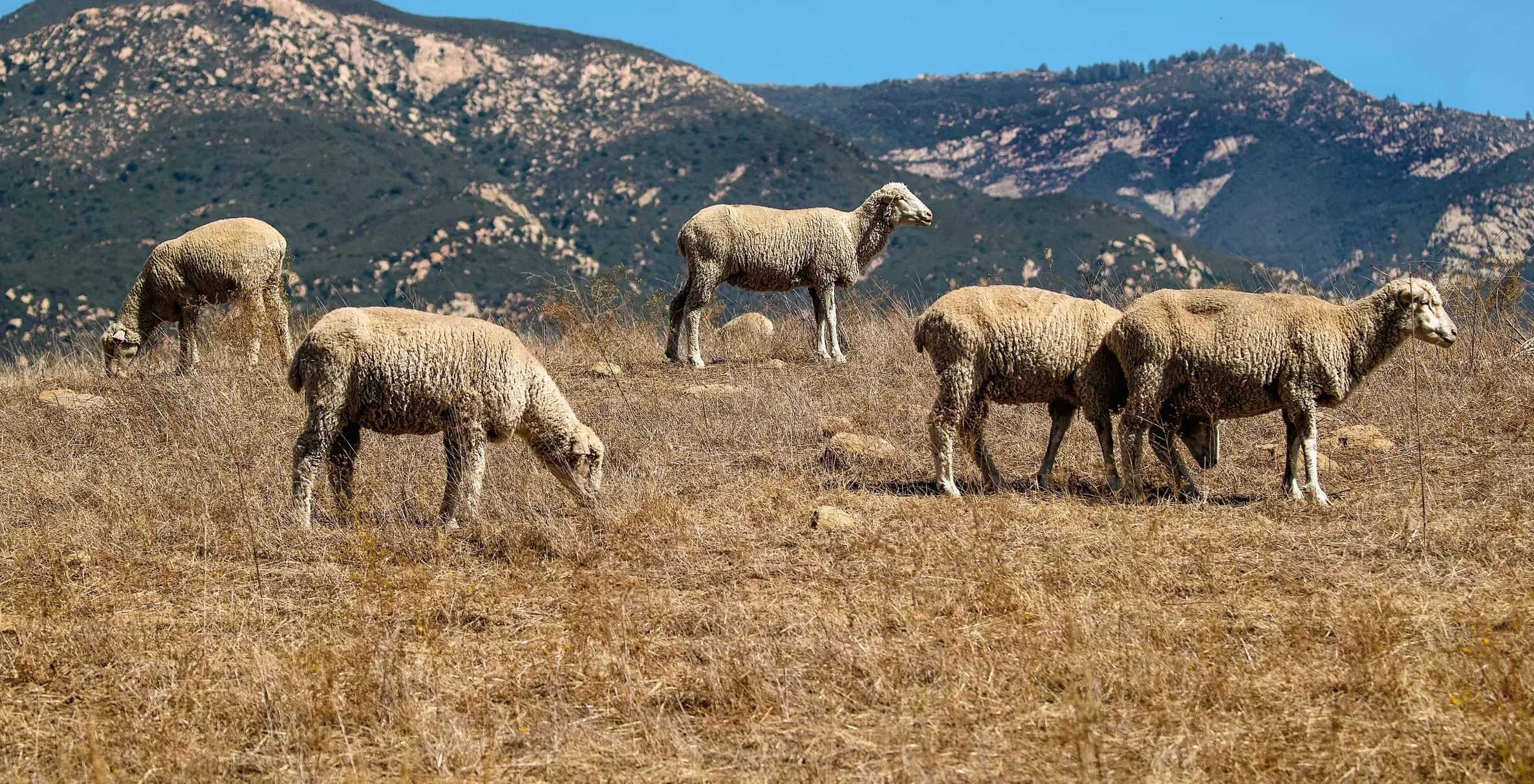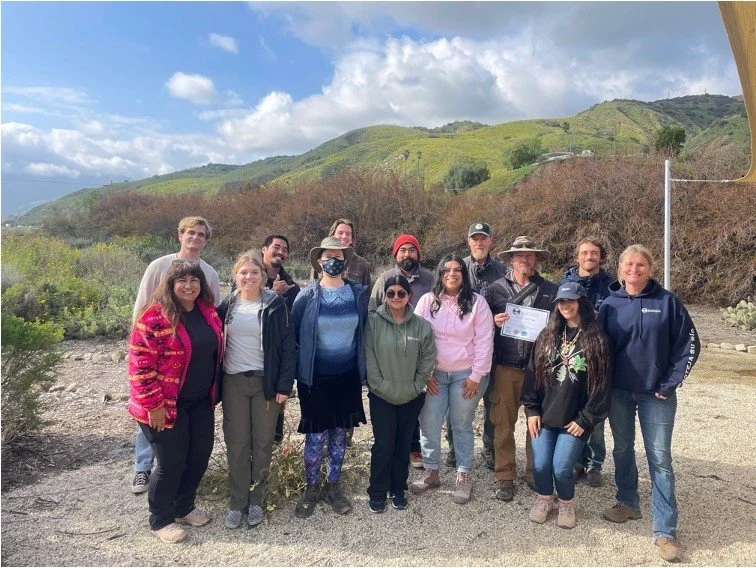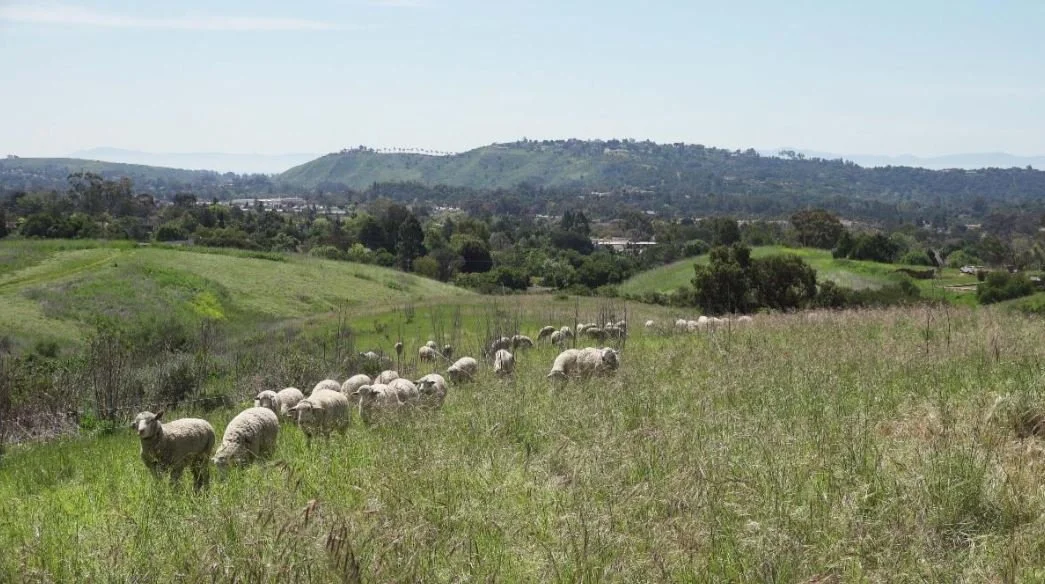This year, Channel Islands Restoration (CIR) has increased our capacity for conservation along the Central Coast! Our field operations team has nearly doubled to accommodate habitat restoration work in Santa Barbara, Santa Paula, Malibu, Thousand Oaks, the Gaviota Coast, and the Channel Islands, to name a few of our project sites.
On one side of a path in the idyllic hills of Santa Barbara, a dense clump of dried out mustard rises more than six feet. Meanwhile, just across the way, the invasive plant is thinned to wisps.
Carolyn Chaney, 77, pointed out the difference in vegetation and also provided the reason: sheep.
“This is where they’ve been,” she said, pointing to the cleared patch of land.
Chaney would know. She’s a regular sheep docent at the 300-acre San Marcos Foothills Preserve, owned by Santa Barbara County and located between Santa Barbara and Goleta.
Carol Gravelle, a long-time volunteer for CIR and a fairly new member of our Board said to me recently, “I’m an island gal, but what you showed us from your desert trip looks amazing!” Maybe only a few of you attended CIR’s annual trips to Death Valley National Park and other locations in the Mojave Desert. Over the course of more than a decade, botanist Steve Junak and geologist Tanya Atwater took us to dozens of amazing desert locales, on trips that sold out just about every year.
Some may remember how the 2023 rainy season began. A few gentle rains in October and November and by News Years we had a nice manageable germination of weeds happening across all our project sites. Conditions were very favorable, and we assumed we would be starting early on many of our projects.
On February 28th, Channel Islands Restoration (CIR) staff gathered at Fillmore City Hall for professional development and knowledge sharing. The workshop aimed to provide field techs with some bilingual skills and riparian knowledge, supporting effective communication between crews in the field and enhancing their understanding of restoration work and related topics such as ecology and natural resource protection.
The goal of the docent program is to provide information and to engage in conversation with visitors of the Foothills. We need your help with explaining this restoration project to people visiting the West Mesa.
One special element of the San Marcos Foothills West Mesa is the perennial spring in the northwest corner that provides the only natural, year-round water source on the entire San Marcos Foothills. The spring was likely used to provide water for cattle during ranching times. At some undetermined point in the past, a long metal pipe was inserted in the hillside at the top of a small arroyo. This pipe apparently converted a natural seep into a controlled stream of water that falls into a bathtub, perhaps placed there at the same time. Water accumulates to as much as 7 to 10 inches in depth, depending on the state of repair of the tub that has cracks in the bottom.
Each spring the Channel Islands Restoration crew head into the Los Angeles National Forest to treat invasive species on the western edge of the Sierra Pelonas just east of I-5. To the west is the inaccessible Sespe Condor Sanctuary and to the east it is just as rugged. A few miles north, the San Andreas fault bisects this path.
Join us to learn to identify our iconic state grass and the non-native grasses that are invading our local habit! This is a beautiful time of year to visit the Foothills and explore the local trails in the area with the community. Make sure to bring a walking pole to help distinguish different plants on the ground but don't worry, the ground is mostly flat and plant identification and training will be provided. No experience is necessary to volunteer, although plant knowledge is helpful!
A few years ago, while working on a CIR habitat restoration project on San Nicolas Island, I noticed that the songs of Western Meadowlarks that I was hearing were noticeably different than those of their counterparts on the mainland (Gevirtz personal observations 2018, 2019). This led me to wonder whether the different songs are distinct local dialects or indicators of distinct subspecies.
We have much to celebrate after an extraordinary 2021, a year in which our community banded together to save the West Mesa of the San Marcos Foothills from development.
The campaign’s success means that Channel Islands Restoration is now responsible for restoring the habitat of rare birds and native plants on the West Mesa. Additionally, the campaign ensures the land is available to the public forever. We take this work seriously, as we know the cultural and historical significance this land holds for our indigenous neighbors and those who recreate in the area.
It was the photo of the Santa Ynez River that came into my inbox last January that ultimately made me sign up for the CIR tamarisk eradication trip. The gorgeous photo shows a crew of backpackers walking along a deep pool in the river, with the blue of the sky reflected in the pool. “Volunteer Sign-up is Now Open!” I was hooked, and having recently completed my vaccination regimen, I was ready for just this kind of adventure.
The Ballona Wetlands, in the coastal area of Los Angeles, were once an extensive expanse of marshes, mud flats, salt pans and sand dunes that covered about 2,000 acres and stretched from Playa del Rey to Venice and inland to the Baldwin Hills. Ballona Creek originally meandered through willows and native habitat, but was cemented into a straight, concrete channel nearly 100 years ago.
The good news is that once again, CIR is working on eradicating tamarisk in the rugged and beautiful watersheds of the Santa Ynez River and Sisquoc River.
Those familiar with the two rivers know how difficult they both are to access. Once off the “more easily” traveled roads and trails, we enter a world that only a small number of people have ever visited. It is a wild and largely untouched world back there, and yet just a few miles away as the condor soars.
From March to July 2020, Channel Islands Restoration worked in the Angeles National Forest northeast of Lake Castaic removing non-native weeds to make room for the native chaparral plants of the area. Plants that we removed include yellowstar thistle, tocolate, and tumbleweed (Russian thistle), all of which are non-native, highly invasive, and highly flammable.
Autumn in the Heritage Valley of the Santa Clara River, the area upstream of Santa Paula and down stream of Piru, is beautiful this time of year.
The mornings are cool and damp. The afternoon temperatures often dip to near tolerable double-digit levels and the smell of freshly tilled dirt is prevalent on the subtle breeze.
Orderly rows of petite greens, herbs and celery, begin to emerge in the fields, lovers of the cool damp mornings that dry into bright sunny afternoons, the same growing conditions that have been ideal for citrus the last 150 years.
In an amazing outpouring of support for the natural world and for the value of open space, CIR has received over 1.3 million dollars in donations and pledges to purchase a portion of the San Marcos Foothills. Most of that funding ($1,035,556 as of this writing) was donated in cash, while $263,228 has been “pledged” to the campaign.
There is nothing quite like a CIR trip to the Santa Barbara backcountry. On each trip, an assemblage of tamarisk mercenaries systematically surveys the designated watershed, leaving no trace aside from a path of tamarisk skeletons in its wake.
Here at Channel Islands Restoration we work in a lot of scenic places - the cliffs of East Anacapa Island, the peaks of Santa Rosa Island, on the sand dunes of San Nicolas Island, along the banks of the Sisquoc River, in the rolling grasslands of the San Marcos Foothills, and more. However, sometimes it’s not so glamorous, and that’s been the experience for many of our field technicians in the past few months.
Early Sunday morning, a group of motivated volunteers met up at the trailhead of San Marcos Foothills to help restore the native habitat. The group spent around three hours pulling out the invasive weeds surrounding the native plants on the Preserve.





















